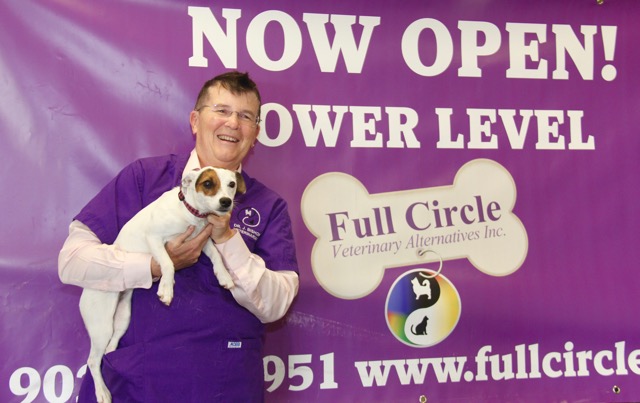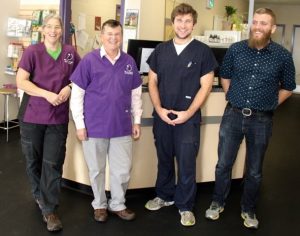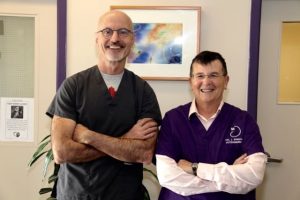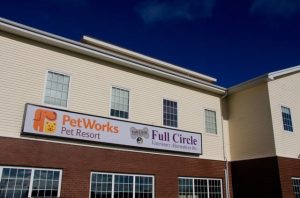A Less Travelled Path: Integrated Practice and VetStrategy
January 10, 2018

My Career as a Veterinarian
When I graduated from the Ontario Veterinary College in 1990, I had the new grad faith that the answers to all the problems I would find in practice lay somewhere in my textbooks or vet school notes. I joined a mixed practice in Truro as an associate to quickly discover that veterinary medicine is so much more complex than any textbook could explain. Part of that discovery was how much of our profession is really about the people attached to the leash, the carrier or the farm. Another component was that textbook knowledge sometimes failed or brought me to a place where I wondered if there wasn’t something else I could offer.
Orthopedic conditions were the first place where I often felt stuck. In the 1990’s we used phenylbutazone on dogs sometimes and ketoprofen was the newest least damaging NSAID. Quite often steroids were used to treat arthritic conditions. The side effects and the absence of knowledge of any other route to follow once the drugs were ineffective, led me to attend a one-day acupuncture seminar and demonstration hosted by a tiny Holistic Health Club at the Atlantic Veterinary College. I was quite skeptical but curious. The lecture component of the course left me thinking that if even ½ of what the acupuncturist said was true, there might be some validity in knowing more. The demonstration broadened my mind and sealed my fate.
First, the AVC students showed us the radiographs of the horse who was about to receive treatment and then the horse hobbled into the demonstration theatre. You did not have to even care about equine lameness, let alone know a thing about it to understand how difficult it was for the horse to move around. As the acupuncturist placed needles, injecting vitamin B12 into various places on the horse’s back, his lower lip grew slack, his penis flopped forward, he partially closed his eyes and resembled being drugged with acepromazine. This was exactly what the acupuncturist had claimed would happen. After a half hour of observation and conversation, the horse was led out walking much better and obviously much more comfortable. I was amazed and wanted to know more.
I took my certification course in acupuncture soon after this. A few years later I investigated Chinese Herbal medicine, then Animal Rehabilitation, then more Chinese herbal medicine, and Bowen therapy. Along the way, my clients taught me that there was more to small animal nutrition than a bag of pet kibble and I became a supporter of whole food feeding, long before social media forced everyone to take a second look.
Eventually, I left my first job to work with another holistic practitioner and to get closer to the numbers of people that could sustain a different way of approaching veterinary medicine. I naively thought that my colleagues would jump at the opportunity to refer their challenging arthritis cases my way and that I would have no trouble being busy. That did not occur exactly as I imagined; however, word of mouth is another way to build a client base. At some point, I realized that I needed to be in the city and that I would have to open my own practice. I borrowed a bit of money from some family members, got a part-time job with a clinic that offered to provide surgical and out of hours coverage for us and late in 1998, I opened Full Circle Veterinary Alternatives.
Starting a Veterinary Business
For several years, our collaboration with the other practice worked well, but as we grew busier our demands for hospitalization and surgical support also grew and the support for the integrated therapies, for instance, giving herbal therapies to hospitalized patients was tenuous. Finally, I bit the bullet and put in all the expensive overhead needed to run a surgery and hospital and we became a stand-alone unit. This was a mixed blessing. While our treatments were ensured, it increased our staff and my management burden significantly. I began to look for like-minded colleagues, hoping for a partnership. Over the years, I had a number of associates who thought they would be interested in buying in but as soon as they had a taste of the reality of the responsibility, they quickly lost interest.
As a small business owner, I was leery of the impact corporate buyouts were likely to have on the Canadian market as I heard of more and more American practices being purchased by large veterinary corporations. I wanted to have my independence and yet the cost to me personally was quite high. As I neared my mid-fifties I knew that I would have to do something to keep Full Circle’s services available for the public and to preserve my own interest in veterinary medicine which was often dwarfed by financial concerns, the perpetual human resources issues including looking for maternity leave replacements and dealing with interpersonal gripes. I fantasized more and more about a simpler job, maybe serving coffee and donuts at Tim’s. Instead of walking away, I picked up a VetStrategy information package at a veterinary conference and let it sit on my desk for at least a year before I contacted them to see if by any chance they might be willing to purchase the practice.
These days, the market for integrative therapies is very different from the 1990’s. The general public is much more aware of options like acupuncture, herbs, nutritional supplements, nutrition, physiotherapy, and chiropractic treatments for themselves and demanding the same for their pets. Veterinarians are also more aware that such things exist for their patients and enough “evidence-based” study has been done on some modalities to lift the veil of disbelief. My current favourite is the board-certified oncologist studying the effectiveness of Chinese herbal medicine in conjunction with surgery and/or chemotherapy and as a stand-alone therapy for various cancers.
Transitioning My Vet Clinic with VetStrategy
Full Circle joined the VetStrategy group in December 2016, following an intense year of back and forth with VetStrategy to work out the details of the purchase price, contracts for me and my associates, staff and a plan to maintain the practice ongoing. We lost some staff who panicked about the sale while some who needed to move on anyway, scuttled away, leaving us with a tight core of the most dedicated. For me, the most difficult part of the negotiations was the time commitment to collecting data and helping to plan the transition while still running a full-time practice.
Our plan was to ensure that the veterinarians at Full Circle were free to do as much integrative medicine and canine rehabilitation as possible. To this end, we decided to move Full Circle into a new space on the ground level of an existing VetStrategy hospital, Petworks. This practice had some rehab equipment, in particular, an underwater treadmill, that we did not have and also had a certified rehab technician. We adopted the Petworks rehab technician and set up a referral process with the full hospital upstairs doing our surgeries and providing some additional conventional support for us. In many ways, this was a reversion to a plan that we had tried once before, but in a time where both parties could see the bigger picture. Initially, we had lots of meetings to understand and blend our philosophies, to iron out and perfect our logistics. The impact of the move and referring our surgeries has been a win-win for both practices. We quickly grew to fill in all the time previously allotted to surgery with patient visits and referral consults. Our revenue stayed stable, even grew without surgery. Our sister practice also benefited with an increase in surgical procedures, helping them to fill underutilized capacity.
After a mere 8 months in our new location, we have grown substantially. We would love to add a second veterinarian with herbal, acupuncture or even homeopathic training to our roster so that I could branch out to doing more education about integrative therapy within our local VetStrategy practices. Our approach to medicine has been untouched, we have acquired few new excellent employees who are learning some new approaches to veterinary practice, while VetStrategy works diligently with our site manager to improve inventory control, HR strategies and to transfer our staff to their new company contracts and employee benefit plans. Overall, we have been able to offer a broader range of services, have become more profitable and more efficient.
Personally, I am still struggling with how exactly do I deal with a full month of vacation that I must take every year. I love that someone else financed the new locale, yet let my team have lots to say about the setup, colour scheme etc. My experience is that overall, we are thriving with our new arrangement and hope to go on in the next years to execute the next steps in our plan to broaden the impact of integrative medicine and animal rehabilitation in VetStrategy practices.



Dr. Jennifer Bishop
Senior Veterinarian
Full Circle Veterinary Alternatives